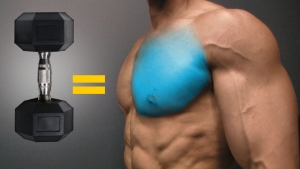The Macro Calculator below will give you an estimate of how many grams of each macronutrient (protein, fats and carbs) you should eat per day based on your body and physical activity level. You can then use this data to determine whether you want to make changes to help support gaining muscle mass or losing body fat.
Fill out the details in the Macro Calculator below based on your current stats and activity level. Be as honest as possible about your actual activity level so that you get the most accurate results.
Your recommended daily calories: 2093
Recommended Daily Macronutrients:
WHY TRACK YOUR MACROS?
Most people rely on calorie counting alone to meet their fitness goals, but that approach misses the bigger picture.
Calories are just part of the equation. Your macronutrient intake matters more than you realize.
The balanced approach of protein, carbohydrates, and fats in your diet has a direct impact on your energy levels, muscle growth, and fat loss.
Take protein, for example.
It’s essential for muscle repair and lean muscle mass. And your protein intake should match your fitness objectives, whether you’re focused on resistance training or aiming for sustainable weight loss.
The same goes for calories from fats and carbs. They’re not the enemy but vital sources of energy when consumed in the right ratios for your activity level and lifestyle.
This is where a macro calculator can help.
It provides accurate measurements for your daily macros based on your calorie intake, activity factor, and body weight.
It simplifies nutrition by giving you the macronutrient ratios tailored to your specific weight goals such as weight loss, weight maintenance, or muscle growth.
No more guessing about your food intake or relying on nutrition labels alone.
With precise macronutrient content and an easy-to-follow macro plan, you’ll know exactly how to build meals that align with your fitness journey.
WHAT ARE MACROS? (SIMPLIFIED SCIENCE)
Macros, short for macronutrients, are the foundation of your nutrition plan, and they play a direct role in your fitness goals.
It doesn’t matter if you’re lifting weights, burning fat, or building endurance, your daily macros determine how your body performs, repairs, and grows.
Macros aren’t just numbers. They’re a personalized nutrition approach that helps you meet your calorie percentages and macro goals.
Think of macros as the construction materials for a house.
Proteins are the bricks, carbs are the power tools, and fats are the glue holding it all together.
You wouldn’t build a house with only one material, and you shouldn’t approach your diet with an imbalance of macros.
The right macronutrient ratio preferences will give you the sweet spot for energy levels, muscle recovery, and effective weight management.
For weight loss, you’ll aim for an accurate calorie deficit to guide your macro ratio and calorie consumption.
For muscle gain, a calorie surplus combined with a balanced macro ratio will ensure adequate macronutrients for muscle repair and growth.
Even weight maintenance requires precise macro tracking to align with your weight maintenance calories and activity level adjustments.
Here’s the breakdown of the three macros you’ll be focusing on:
PROTEIN
Protein is the muscle builder. Protein is essential for muscle repair, lean body mass, and preventing muscle breakdown during a calorie deficit.
It’s measured in grams of protein per pound of body weight, with fitness coaches recommending higher protein intake during strenuous activity or resistance training.
Foods like lean beef, egg whites, and even protein supplements deliver the essential amino acids your body needs to fuel muscle growth and recovery.
CARBS
Carbs are the energy provider. Whether they’re complex carbohydrates like sweet potatoes or fibrous carb vegetables like spinach, carbs are your body’s primary source of energy for exercise and daily activities.
Carb intake fuels physical activity levels and helps maintain energy during intense workouts.
Fitness experts often recommend adjusting your carb content based on your activity level, from sedentary lifestyles to the calorie demands of a construction worker or athlete.
FATS
Fats are the hormone regulators. Found in sources like almond butter, coconut oil, and even cheese, dietary fats are crucial for bodily functions and hormone production.
Fats deliver nine calories per gram, compared to only four calories per gram from protein and carbs, making them the most calorie-dense macro.
The key is to focus on healthy fat sources while monitoring fat intake to avoid surpassing your daily calorie limit.
WHY YOU NEED A MACRO CALCULATOR
Winging it with your nutrition isn’t going to cut it. You can’t rely on guessing your food intake or eyeballing your portions and expect results.
A macro calculator takes the guesswork out of the equation, giving you precise daily macros tailored to your current weight, physical activities, and nutrition goals.
Here are some ways that a macro calculator can help you hit your fitness goals:
PERSONALIZED NUTRITION, SIMPLIFIED
Your daily energy expenditure isn’t the same as your neighbor’s, your co-worker’s, or even the average person’s.
A construction worker and someone with a desk job have vastly different calorie and macronutrient needs.
A macro calculator takes into account your basal metabolic rate, activity level adjustments, and dietary preferences to create a nutrition plan that works specifically for you.
For example, if your goal is weight loss, it calculates the ideal caloric deficit while ensuring you hit the right ratio of protein, carbs, and fats.
If you’re aiming for muscle growth, it sets a calorie surplus with accurate macros to fuel recovery and muscle repair. This level of customization beats any one-size-fits-all diet.
ENSURES BALANCED MEALS AND FOOD CHOICES
It’s easy to get stuck eating the same foods day after day, but a macro calculator encourages variety while keeping your nutrition goals intact.
Tracking macros also helps you include more dietary fiber from fibrous carb vegetables or soluble fiber from oats, which improves digestion and keeps you full.
You’ll be less likely to grab unbalanced, high-calorie foods that don’t align with your macro goals.
HELPS YOU AVOID UNDEREATING OR OVEREATING
Many people underestimate how much they need to eat for effective weight loss or muscle gain.
A macro calculator provides an accurate measurement of your daily calories and macros, ensuring you hit your nutrition goals.
For instance, it prevents you from cutting your calories from protein too low, which could lead to muscle loss, or overloading on fats, which could stall fat loss.
For those with sedentary lifestyles, it calculates sedentary calorie expenditure, so you don’t overshoot your calorie intake.
On the other hand, if you’re involved in strenuous activity or strength training, it adjusts your macros for higher energy needs.
BUILDS CONSISTENCY WITH EASY TRACKING
Consistency is king in fitness, and a macro calculator makes it simple to stay on track.
By breaking down your macros per meal and even providing templates for a 7-day macro-based meal plan, it helps you stick to your goals daily.
You’ll know exactly how much protein per pound of body weight you need, how many grams of fat to include, and what your carb intake should be.
Using tools like a calorie tracking app, you can monitor your food intake and ensure you hit your macro targets without feeling overwhelmed.
Over time, this builds habits that make proper nutrition feel effortless.
ADJUSTS TO YOUR CHANGING LIFESTYLE AND FITNESS JOURNEY
As your body changes, so should your macros. A macro calculator helps you recalibrate your macro ratio and calorie percentages as you progress toward your fitness goals.
For example, a macro calculator can guide you in shifting from a caloric deficit for fat loss to a maintenance phase where you consume the right balance of daily macros for long-term results.
It’s an adaptable tool that grows with you.
SUPPORTS SPECIFIC DIETS AND PREFERENCES
Whether you follow a ketogenic diet, prefer high-protein meal plans, or need to manage specific food intolerances, a macro calculator helps you fine-tune your macros to meet your dietary approach.
It ensures your macronutrient content aligns with your acceptable macronutrient distribution ranges, whether you’re limiting calories from carbohydrate or boosting calories from protein.
No matter your nutrition style, from eating mozzarella cheese and sweet potatoes to using coconut oil and omega-3 fatty acids, a macro calculator provides the structure you need to stay balanced.
HOW A MACRO CALCULATOR WORKS
A macro calculator is a precision tool designed to take the guesswork out of your nutrition game, aligning your food intake with your fitness goals.
By analyzing a few personal inputs and using proven formulas, it provides a clear breakdown of your macronutrient per day requirements for effective weight management, muscle gain, or fat loss.
WHAT GOES INTO A MACRO CALCULATOR
To calculate your daily macro needs, you’ll need to input the following:
- Age and Gender: These influence your basal metabolic rate (BMR), which is the calories that the human body burns daily for basic bodily functions like breathing and digestion.
- Weight and Height: Used to determine your current calorie needs and to calculate your body fat percentage if known.
- Activity Level: Whether your current lifestyle involves gentle activities, an exercise routine, or more intense physical exertion, this adjustment accounts for your energy expenditure beyond BMR.
- Fitness Goals: Are you on a weight loss journey, aiming for weight maintenance, or looking to build excess muscle? Your macro for weight loss, maintenance, or bulking will depend on this choice.
THE FORMULA: TOTAL DAILY ENERGY EXPENDITURE (TDEE)
The macro calculator first determines your Total Daily Energy Expenditure (TDEE) which is the total calories you burn in a day, including all physical activity.
This is calculated by multiplying your BMR by an activity factor: TDEE = BMR × Activity Factor
BMR Calculation (Mifflin-St Jeor Formula):
For men:
- BMR = 10 × weight (kg) + 6.25 × height (cm) – 5 × age (years) + 5
For women:
- BMR = 10 × weight (kg) + 6.25 × height (cm) – 5 × age (years) – 161
Activity Factor:
- Sedentary: 1.2
- Lightly active: 1.375
- Moderately active: 1.55
- Very active: 1.725
- Extremely active: 1.9
MACROS BASED ON YOUR GOALS
Once your TDEE is calculated, the macro calculator allocates your daily calories into macronutrient ratios based on your goals.
Weight Loss (Caloric Deficit):
To lose fat while preserving lean mass, a caloric deficit (10–25% less than TDEE) is applied.
This ensures your body taps into stored fat for energy while maintaining enough protein for muscle repair.
- Protein: Aim for ~1 gram of protein per pound of your ideal body weight. For example, include foods like cottage cheese, lean beef, or protein supplements to meet your needs.
- Carbs: Allocate the rest of your calories to carbs, focusing on complex carbohydrates like sweet potatoes and fibrous carb vegetables to maintain energy and keep hunger in check.
- Fats: Use healthy fat sources like avocado, almond butter, or macadamia nuts. Keep fat portions smaller to allow room for protein and carbs, ensuring your meals are balanced without going overboard on calories.
Muscle Gain (Caloric Surplus):
A caloric surplus (10–20% more than TDEE) gives your body the fuel it needs to repair muscle and promote growth after workouts.
- Protein: Keep your protein intake moderate but consistent at about 1 gram per pound of your current weight +to support muscle repair.
- Carbs: Prioritize carbs to meet your energy demands, especially if you’re engaging in strenuous activities like resistance training. Incorporate foods like oatmeal, rice, and bananas to sustain performance.
- Fats: Add small amounts of healthy fats like olive oil, peanut butter, or seeds to meals as a complement, but let carbs and protein take the lead in your nutrition plan.
Weight Maintenance:
For weight maintenance, your goal is to match your calorie intake to your TDEE to sustain your current weight and body composition.
- Protein: Continue with ~1 gram of protein per pound of body weight to preserve lean mass.
- Carbs: Maintain a balanced intake of carbs to fuel daily activities and workouts while preventing energy dips.
- Fats: Use fats as a garnish to round out meals, adding avocado slices to salads, a drizzle of olive oil on vegetables, or a small portion of cheese for flavor.
HOW TO SPLIT MACROS
Each macronutrient plays a specific role in your fitness journey, from fueling your workouts to supporting recovery and maintaining energy levels.
Let’s take a closer look at how a macro calculator splits your daily calorie intake into actionable numbers.
Protein: 4 calories per gram
Carbohydrates: 4 calories per gram
Fat: 9 calories per gram
For example, if your TDEE is 2,000 calories and you aim for a 40/30/30 macro split:
- Protein (30%): 600 calories ÷ 4 = 150 grams of protein
- Carbs (40%): 800 calories ÷ 4 = 200 grams of carbohydrates
- Fats (30%): 600 calories ÷ 9 = ~67 grams of fat
By focusing on your nutrition goals and providing accurate macros, a macro calculator ensures every calorie counts toward your ideal outcome,
It’s a key tool for anyone in the fitness community looking to optimize their nutritional approach.
COMMON MACRO MISTAKES TO AVOID
Hitting your macro goals isn’t just about plugging numbers into a macronutrient calculator. You’ve got to know how to apply those numbers in real life.
Here are the most common macro mistakes that sabotage progress and how to avoid them:
MISJUDGING PORTION SIZES
Guessing portion sizes is a fast track to derailing your nutrition calculator results.
A tablespoon of peanut butter can easily turn into three if you’re eyeballing it, and those extra grams of fat add up fast.
Use a food scale, check the food label, and measure out your servings of beef protein, cheddar cheese, or even your favorite keto foods to stay on track.
IGNORING FOOD QUALITY
The “If It Fits Your Macros” (IIFYM Macronutrient) approach doesn’t mean you should fill your macros with junk.
Sure, you could hit your protein calories with cream cheese and processed meats, but your body thrives on quality acids in protein found in lean beef, egg whites, and fish.
A healthy diet is about more than just calories; it’s about fueling the chemical reactions your body needs to perform at its best.
SKIPPING TRACKING CONSISTENCY
Macro tracking isn’t something you can half-commit to. To achieve your goal weight, you’ve got to track your macros daily.
Whether it’s your calories from carbs, your gram of fat intake, or your moderate protein consumption, consistency matters.
Skipping days or guesstimating your carb consumption leaves too much room for error, throwing off your ratio for weight loss or muscle gain.
OVER-FOCUSING ON ONE MACRO
Don’t put all your energy into just one macro.
Loading up on protein calories while neglecting your carbs and fats can leave you feeling sluggish and low on the nutrient amounts for energy that your workouts demand.
On the flip side, overloading on carbs can push you past your carb limit, especially if you’re following a keto food list or a low-carb diet.
A comprehensive approach ensures your macros are balanced and aligned with your fitness goals.
Macros fuel your body needs to build muscle, burn fat, and crush your fitness goals.
With the right macro breakdown, you’ll stop spinning your wheels and start seeing real results.
Don’t leave your nutrition to chance. Use a macro calculator, lock in your plan, and take control of your progress starting today.
Don’t have a fully fleshed out nutrition and fitness program that can help you achieve the weight loss or weight gain you’re after? We can help! Check out our ATHLEAN-X programs to see which is the best fit for your goals and fitness level.

- Calories alone don’t tell the full story. Your macronutrient intake determines how your body builds muscle, burns fat, and maintains energy.
- Protein: Builds and repairs muscle (e.g., lean beef, egg whites).
- Carbs: Your primary energy source (e.g., sweet potatoes, spinach).
- Fats: Supports hormones and bodily functions (e.g., avocado, almond butter).
- A macro calculator personalizes your daily macro needs based on factors like age, weight, height, activity level, and goals.
- It also helps achieve specific objectives, such as weight loss (caloric deficit), muscle gain (caloric surplus), or weight maintenance.
- To calculate your macros, you start with your TDEE: Total Daily Energy Expenditure (TDEE) = Basal Metabolic Rate (BMR) × Activity Factor.
- This provides the baseline for splitting your calories into macronutrient ratios tailored to your fitness goals.
- Once you have your TDEE, you can adjust your caloric intake based on your goals:
- Caloric Deficit for Weight Loss: Subtract 10–25% from your TDEE to shed fat while maintaining lean muscle.
- Caloric Surplus for Muscle Gain: Add 10–20% to your TDEE to fuel muscle repair and growth.
- Maintenance for Stability: Match your calorie intake to your TDEE to sustain your current weight and energy levels.





































